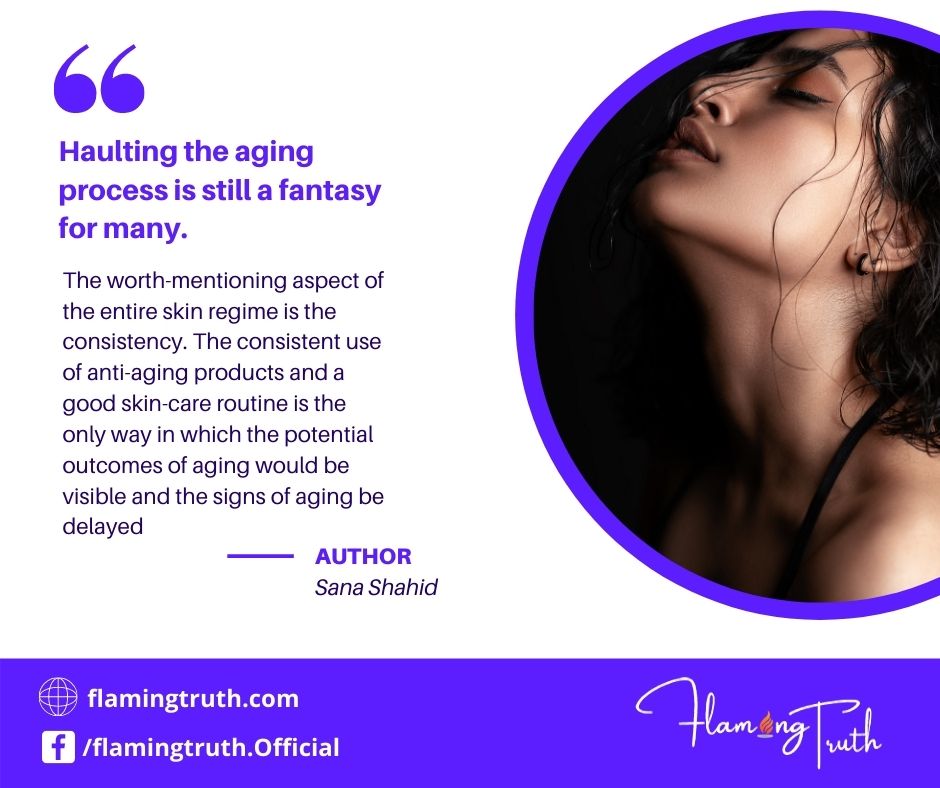Skin aging is a complex biological process. It is a part of a natural human “aging mosaic” which becomes evident with time. Aging occurs due to the development of the tissues and organs in the body, with the passage of time.
The earliest signs of skin aging begins with the appearance of wrinkles and fine lines, followed by a number of other signs like dull and dry skin, visible pores, loss of skin elasticity, rough skin texture, uneven skin tone etc.
They appearance of these signs is usually observed in the late 20s and early 30s, which of course varies from person to person, depending upon the individual’s dietary, lifestyle as well as skin-care practices.
The health of the skin is one of the chief factors that characterizes the wellness of an individual. While the skin has three layers (epidermal, dermal and subdermal layers), each of these layers is affected distinctly by the skin aging process. Researchers have pretty much succeeded in mastering strategies to decrease aging; however, haulting the aging process is still a fantasy for many.
Factors influencing Skin Aging
Skin aging begins by a combination of intrinsic and extrinsic factors.
Intrinsic factors of Skin Aging
Intrinsic factors are the ones that affect the skin cells to from within, either via hormonal changes, genetic modifications or poor blood supply. These factors are mostly predetermined depending on the genetic fate of an individual.
- The genetic factors include shortening of telomeres (nucleotide sequences) and DNA mutations that cause significant changes in skin textures and appearance. Irrespective of the skin conditions, these factors appear naturally with advancing age.
In intrinsically aging skin, the proteins molecules such as elastin, fibrillin, collagen etc. undergo degeneration at a very rapid rate, thus altering the water retention capacity of the cells. The loss of elasticity, therefore, causes skin sagging. However, in addition to the general factors affecting the process, specific cell types act differently. For instance, the phototype I –II skin (fair skin, often termed as sensitive skin) people are more likely to observe wrinkles at an early age, in comparison to the dark phototype people (V-VI). Contrastingly, people with moderate phototype III skin are more prone to uneven skin tone.
- The hormonal influences on aging are also undeniable. The declining Estrogen levels cause atrophic skin modifications and accelerate the aging process. The immune and nerve responses in the skin cells are also reduced due to lowering Estrogen levels. The oxidative stress increases due to compromised immune responses, causing the skin thinning, enhanced wrinkling and dryness and reduced vascularity.
Extrinsic factors of Skin Aging
Various extrinsic factors act on the skin cells and promote the aging process due to environmental factors. The extrinsic factors associated with skin aging were first reported during the late nineteenth century. The basic mechanism of action behind all the extrinsic factors is the enhanced oxidative stress. All the factors act either solely or in collaboratively to release free radicals that degenerate crucial skin components such as hyaluronic acid, collage, elastin and other cell structures.
In normal circumstances, the free radicals combatt with the antioxidants present within the skin, which in trun reduces the free radical combatting ability of the skin. This leads to aging signs. Moreover, the presence of multiple extrinsic factors, accelrates the entire process by many folds.
- Sunlight exposure is the primary culprit in the extrinsic aging. UV rays trigger photo-aging and uneven pigmentation. Excessive exposure to UV radiations cause DNA mutations and, in some cases, carcinogenesis (cancer cell formation). The changes induced by sun’s UV radiations vary for different people and the repairing capacity for everyone is also distinct.
The best a person can do to him/herself is to use sunscreen for UV protection. Never skip this step in any case.
- Pollution is another major cause of various skin issues. The increasing pollution in urban areas has blemishing effects on the skin as it provokes the discharge of free radicals in the skin cells and enhances oxidative stress.
- Smokers experience an upsurge of oxidative stress, owing to the ingredients of the cigarettes.
- Poor dietary habits of an individual may act as the cherry on top. However, contrastingly, good diet and nutrition, i.e.; diet rich in antioxidants has the ability to reduce the oxidative stress and negatively impact the rapid skin aging process.
- Last but not the least, skin care plays a very important part in this respect. The products used for skin pose a huge impact on the skin texture and condition. The wrong products could make the skin irritable and cause more harm than good. thus wisely chose skin care routine and targeted skin care products, depending upon the your skin type.
Anti-Aging Products
Various anti-ageing methods which help the user to look younger for a longer time period, slows down the aging process. Due to this, various anti-aging strategies have been developed during the previous years and have gained immense appreciation by the consumers.
The process of ageing can be retarded by using different anti-ageing methods in order to stay young and beautiful for a longer time period. Different methods of anti-ageing treatment include anti-ageing drugs. The anti-ageing drugs tend to increase the skin texture and moisture of the body. The anti-ageing skincare products also help to re- form the body by lowering the fat content of the body.
Read more : 10 Home Remedies that treat your skin allergies naturally!
Ingredients Of The Anti-Aging Drugs
The ingredients of the anti-aging drugs include.
- Retionols (vitamin A) are active anti-oxidant compounds. These are one of the best anti-ageing ingredients. Retinols neutralize free radicals. Besides this, retinols speed cell turnover, lightened superficial brown spots, smoothen the wrinkles and boost elastin and collagen production by skin.
- Peptides are also the ingredients of the anti-ageing creams. The peptides are used as a natural anti-ageing treatment. These peptides include mainly elastin and collagen peptides. With growing age, the skin tends to lose elasticity and becomes thinner and saggy due to the less production of elastin and collagen proteins. Therefore, the peptides within the creams help to stimulate the production of new cells and maintain the elasticity of the skin. This thus works perfectly on wrinkles.
- Various alpha-hydroxy acids such as glycolic acid, lactic acid and citric acid are important components of milk and sugar. These acids work together as exfoliants. The exfoliants tend to remove upper worn-out layer of dead skin cells and stimulate the production of new skin cells.
- The use of anti-oxidants such as vitamin C and E is very beneficial for the skin as they help the skin cells to fight against the free radicals. Other anti-oxidants include selenium, lycopene and beta-carotene.
- Niacinamide is a derivative of vitamin B3. It has both anti-oxidant as well as moisturizing actions. It improves skin elasticity and retains water in the skin.
- Hyaluronic Acid is a natural moisturizer and anti-dehydrating agent within the skin. Addition of this compound within the creams and other anti-ageing products helps retain water in the skin and prevents dehydration. It is also known to reduce fine lines.
- Resveratrol is a plant derivative and is also an ingredient of the red wine. It slows down the age related decline. It is also effective in skin burns, skin ulcers and wound healing.
- Other ingredients included in the anti-ageing products are coenzyme Q10, tea extracts, grape seed extract and vitamin C serum etc. These ingredients protect the skin from sun damage, aid in wound healing, produce new collagen and also possess anti-inflammatory properties.
Conclusion
The anti-aging products available in the market contain a majority of the above-mentioned ingredients for maximum effectiveness. Thus investing in skin care and anti-aging products is always a good deal as it is a direct investment in a person’s beauty and self care. Initiate the use of anti-aging products once the skin begins to mature, i.e.; during the late 20s.
The correct application of the product is also important in this regard, as it ensures the maximum absorption into the skin. The areas that need special attention are forehead, the under eye region, furrow between the brows and the smile lines. An effective serum, a good moisturizer and an eye cream paired with appropriately managed weekly skin-care routine is the guarantee to a healthy looking skin that everyone longs for.
The worth-mentioning aspect of the entire skin regime is the consistency. The consistent use of anti-aging products and a good skin-care routine is the only way in which the potential outcomes of aging would be visible and the signs of aging be delayed.

















0 Comments